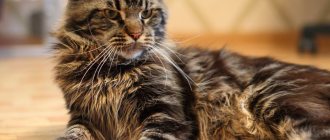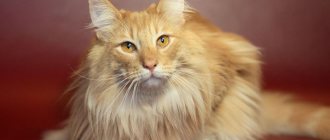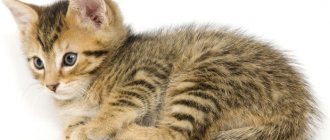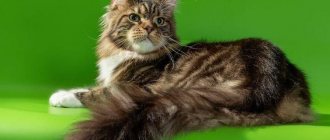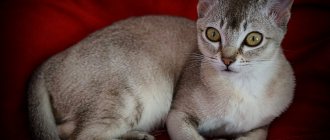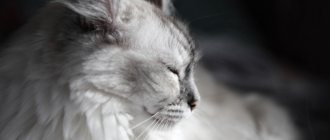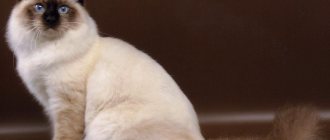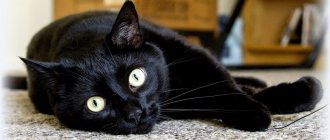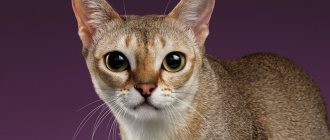08/31/2015 Category: Pets Author: Natalya Ivantsova
Cats are very affectionate and kind creatures. They have been living next to us for more than ten thousand years, and today they are one of the most popular pets. There are many breeds of cats. Some of them appeared naturally, others were bred artificially by breeders.
However, they are all beautiful and unique in their own way. Prices for purebred cats vary greatly. First of all, they depend on the uniqueness of the species. We bring to your attention a list of the most popular cat breeds among Russian residents.
- Peterbald or St. Petersburg Sphynx
- Himalayan cat
- Scottish Fold or Scottish Fold
- Canadian Sphynx
- British Shorthair
- Maine Coon
- Laperm
- Russian blue
- American Curl
- Bengal cat
- Video: Popular cat breeds
Devon Rex
These cats are very smart and easy to train; they can master even the most difficult tricks without much effort.
This short-haired breed first appeared in 1960 in Great Britain. Its representatives have a very unusual appearance: their fragile body is covered with soft curly fur, and the size of their ears is unusually large. These cats are very smart and easy to train; they can master even the most difficult tricks without much effort. Devon Rex is a hypoallergenic breed. This further increases its popularity. One “alien” cat with all the documents and pedigree will cost you about 350-1250 dollars.
Peterbald or St. Petersburg Sphynx
These cats have no hair, sometimes there is a small fluff
This breed was first developed in 1994 in Russia after crossing an Oriental cat and a Don Sphynx. These cats have no hair, sometimes there is a small fluff. Representatives of the breed have a slender body, an elongated head and pointed ears set apart in different directions. They are very curious, friendly and affectionate, and are very trainable. The cost of a kitten ranges from 300-1300 dollars.
Siberian
The Siberian cat is a breed that is popular not only in Russia. These pets are loved for their beautiful appearance and wonderful character. These animals are very sociable and friendly, without vindictiveness. They are distinguished by good health and ease of care.
A distinctive feature of the breed is its very thick and long coat, which makes it easy to withstand even extreme cold. It is believed that the appearance was influenced not by artificial selection, but by nature itself. Relationship with wild cats is indicated not only by color, but also by physique. Siberians have it compact and powerful. The resemblance to a lynx is added by the presence of tufts on the ears.
Himalayan cat
This breed is a cross between a Persian and a Siamese.
Beautiful long-haired Himalayan cats resemble Persians in appearance. They are almost identical, except for the eyes and unusual coloring. Himalayan cats were bred in the United States in 1950. This breed is a cross between a Persian and a Siamese. However, there are still differences, especially regarding character. Himalayan cats are less playful, very active and friendly. The character is affectionate and non-aggressive. On average, the cost of one kitten varies from $500 to $1,400.
Scottish Fold or Scottish Fold
Fold cats are very playful, intelligent, with a balanced disposition.
This is a very interesting breed of cat. The main difference between its representatives is the unusual auricle. The ears of these cats are curved forward and down. This feature is a consequence of a gene mutation. The breed was developed in 1961 in Scotland. Fold cats are very playful, intelligent, and have a balanced disposition. They get along well with both adults and children. In addition, the Scots have a number of unique characteristics. The first is their extraordinary voice. It is more creaky than that of ordinary cats. Also, “Scots” can stand on their hind legs for a long time and look around. Fold cats love to sit in an L-shaped position with a straight back and outstretched paws. The cost of cats ranges from $300 to $1,400.
This is interesting: In the Far East, scientists knew about this breed a couple of centuries ago. In 1795, an article appeared in a magazine that described traditions and life in China. There they mentioned the Scottish Fold. But in Europe they appeared only in the twentieth century.
Canadian Sphynx
Sphinxes are famous for their sociability, peace-loving and friendly nature.
Hairless cats first appeared in Canada in 1966, however, there is evidence that they existed in Ancient Egypt. Sphinxes are famous for their sociability, peaceful and friendly nature. These are very graceful and energetic creatures, incredibly intelligent and devoted to their owners. Often representatives of this breed can be found doing their most favorite pastime: sphinxes spend a lot of time in bizarre poses, thoughtfully looking at some object. You can buy a thinking cat for 400-1500 US dollars.
Kurilian Bobtail
The Kurilian Bobtail is another breed that belongs to the aboriginal group. A distinctive feature is a fluffy and short pom-pom tail.
Cats have a bright and memorable appearance:
- strong and compact build;
- powerful legs, heavily covered with hair;
- a lush mane on the neck and abundant fur throughout the body;
- a muzzle with the features of a wild animal;
- wide powerful cheekbones;
- piercing look.
There are two varieties of the breed – shorthaired and semi-longhaired. The color can be varied. The standard does not allow such colors as chocolate, lilac, cinnamon, fawn.
Kurilian Bobtails not only have an original appearance, but also a unique character. In behavior and type of temperament, they are more like dogs. Cats of this breed are very loyal to their owners and very obedient. Only one person is considered the owner. They treat other family members calmly and friendly. Their easy-going nature allows them to coexist peacefully with other pets, even dogs.
British Shorthair
British Shorthairs come in medium and large sizes
British Shorthairs come in medium and large sizes. This breed was officially recognized only in 1984. Its representatives have a very beautiful and unusual color; the most popular option is considered solid (lilac, black, blue and chocolate). The British have an English aristocratic character; they are not alien to feelings of restraint and pride. As for girls, they are much calmer and not as gentle as boys. They don't need a lot of attention as cats love being alone. But when the desire to play arises, hold on, owners! The cost of one aristocratic British is 500-1500 dollars.
Maine Coon
Their favorite pastime is purring and meowing loudly.
One of the largest breeds of cats was bred on a farm in Northeast America in Maine. In appearance, these animals are similar to raccoons; they have a black and white striped color and a large fluffy tail. Maine Coons are very large, their weight can reach from 5 to 15 kg, body length - 1.23 m. This breed seems formidable, but people call such cats gentle giants. Representatives of this breed are kind, playful, love to play and indulge. Their favorite pastime is purring and meowing loudly. The owners love it. You can buy a singing cat for $600-1500.
This is interesting: In natural conditions, these individuals live, like lions, in prides. And the main ones in them are not cats, but cats. The place in the hierarchy is determined by the age of the animal.
Ragdoll
Features of appearance. Large animals.
They have semi-long, silky hair that even grows between the pads of their toes. By the way, this is one of the distinctive features of the breed. Associations allow only three types of colors: colorpoint, bicolor and mitted. Ragdolls develop their color by the age of two.
Character. Calm and balanced animals, very reserved and lazy. They get along well with other pets and get along with children.
They love to play, but it is enough to devote a few minutes a day to this activity; the rest of the time cats prefer to lie down, doze or watch others.
Care. Do not require special care. The only required daily procedure is combing.
Russian blue
The main distinguishing feature is short blue fur with an unusually beautiful silver tint.
Russian Blue is a very popular breed among Russians. These short-haired cats first appeared in 1893 in Russia. The main distinguishing feature is short blue fur with an unusually beautiful silver tint. These cats are very smart, loving and obedient, however, sometimes they can show their character and stubbornness. There is a belief that people who own a cat of this breed will be lucky and rich. You can buy it for 350-2000 US dollars.
The most popular cat breeds. Top 20 (with photos)
19th place. Burmese cat (Burmese) . The short-haired breed is native to Southeast Asia. In Burma (modern name Myanmar), such cats were kept in Buddhist temples and were considered the reincarnation of deceased monks.
see also Buddhist Cats
18th place. The Siberian cat is a famous Russian breed of semi-long-haired cats, which got its name due to its place of origin - Siberia.
17th place. The Tonkinese cat is a hybrid of the American-type Siamese and Burmese cats.
16th place. Russian Blue . The breed traces its origins to the cats of the ancient Slavs. This breed became known outside Russia in 1893, when the English breeder Karen Cox brought two blue kittens from Arkhangelsk. The main distinguishing feature of the breed is its short blue coat with a beautiful silver tint. Russian Blue is one of the most expensive cat breeds.
15th place. The Burmese cat (sacred Burmese) is a breed of semi-long-haired cat that originates from Burma (Myanmar). It should not be confused with the Burmese cat, which is a separate breed of short-haired cat. The Burmese cat is recognizable due to its unusual color, which is called the Burmese color after the name of the breed. Cats with this color are characterized by the presence of white “gloves” with the point color of long hair.
14th place. The Norwegian Forest Cat is a breed of domestic semi-longhaired cat originally from Norway. The breed's ancestors were ship's cats on Viking longships.
13th place. Cornish Rex . A short-haired breed of domestic cat originally from Great Britain. The main distinguishing feature of the Cornish Rex is their coat. It has no guard hairs, and the undercoat is curled into a dense wave, reminiscent of astrakhan fur in structure.
12th place. The Siamese cat is a breed originally from Thailand (its old name is Siam).
11th place. The Devon Rex is a breed of short-haired domestic cat that originated in Great Britain. Representatives of this breed have a very extraordinary appearance: their fragile body is covered with soft curly hair, and their head is decorated with huge ears.
10th place. Oriental cat (oriental) . This shorthaired breed's ancestors are from Thailand, but it officially originated in the United States.
9th place. The Canadian Sphynx is a breed of hairless cat whose history officially began in 1966 in Canada, but there is evidence that these unusual creatures were known back to the times of the Egyptian pharaohs and were common in the Aztec and Incas temples in ancient Mexico.
8th place. The Abyssinian cat is one of the oldest cat breeds. Abyssinia is the former name of Ethiopia, where this breed originates.
7th place. The Scottish Fold (or Scottish Fold) is a very interesting breed of cat, the main distinguishing feature of which is the characteristic structure of the ears, curved forward and down. This unusual detail of their appearance is a consequence of a gene mutation. The first representative of this breed was discovered in 1961 in Scotland.
6th place. American shorthair cat . The ancestors of this breed were brought by the first settlers from Europe to North America.
5th place. British shorthair cat. This breed is the most popular in the UK.
4th place. Ragdoll is a breed of semi-long-haired cat. The name of the breed is translated as “rag doll”, because. Ragdolls phlegmatically accept any actions towards them: they can be stroked, squeezed, or put in certain positions.
3rd place. The Maine Coon is a large breed of domestic cat whose ancestors lived on the farms of Maine (Northeast America). Due to their original black striped color and large fluffy tail, they looked like raccoons - hence the second part of the name “coon”, that is, “raccoon”.
see also The largest breeds of domestic cats
2nd place. Persian cat . The ancestors of the modern breed were taken from Persia (modern name Iran) to Italy in the 17th century. In 2012 and 2013, the Persian cat was the most popular breed in the world, but in the last two years it has been content with only second place.
1 place. The exotic cat (exotic cat) is a breed of shorthair cat artificially created by American breeders in the 1960s by crossing American shorthair cats with Persian cats. In 2014 and 2015, exotics managed to surpass in popularity even their long-haired ancestors - Persian cats.
see also The rarest cat breeds
American Curl
These cats are very inquisitive, friendly and playful.
The American Curl is a breed of shorthaired cat that was first bred in California in 1980. They have unusual folded back ears. Outwardly, they resemble small horns. The most interesting thing is that when curls are born, their ears are completely normal, but they curl up only after several days of life. These cats are very inquisitive, friendly and playful. Curls are loyal and quickly adapt to their new home. The cost of a faithful friend with funny ears ranges from 1100 to 2000 US dollars.
Popular cats in Russia
1. General provisions This personal data processing policy is drawn up in accordance with the requirements of the Federal Law of July 27, 2006. No. 152-FZ “On Personal Data” and determines the procedure for processing personal data and measures to ensure the security of personal data of milota (hereinafter referred to as the Operator). The operator sets as its most important goal and condition for carrying out its activities the observance of the rights and freedoms of man and citizen when processing his personal data, including the protection of the rights to privacy, personal and family secrets. This Operator’s policy regarding the processing of personal data (hereinafter referred to as the Policy) applies to all information that the Operator can obtain about visitors to the website https://milota.online/.
2. Basic concepts used in the Policy Automated processing of personal data – processing of personal data using computer technology; Blocking of personal data – temporary cessation of processing of personal data (except for cases where processing is necessary to clarify personal data); Website – a collection of graphic and information materials, as well as computer programs and databases that ensure their availability on the Internet at the network address https://milota.online/; Information system of personal data - a set of personal data contained in databases, and information technologies and technical means that ensure their processing; Depersonalization of personal data - actions as a result of which it is impossible to determine without the use of additional information the ownership of personal data to a specific User or other subject of personal data; Processing of personal data – any action (operation) or set of actions (operations) performed using automation tools or without the use of such means with personal data, including collection, recording, systematization, accumulation, storage, clarification (updating, changing), extraction, use, transfer (distribution, provision, access), depersonalization, blocking, deletion, destruction of personal data; Operator - a state body, municipal body, legal or natural person, independently or jointly with other persons organizing and (or) carrying out the processing of personal data, as well as determining the purposes of processing personal data, the composition of personal data to be processed, actions (operations) performed with personal data; Personal data – any information relating directly or indirectly to a specific or identified User of the website https://milota.online/; User – any visitor to the website https://milota.online/; Providing personal data – actions aimed at disclosing personal data to a certain person or a certain circle of persons; Dissemination of personal data - any actions aimed at disclosing personal data to an indefinite number of persons (transfer of personal data) or familiarizing with personal data to an unlimited number of persons, including the publication of personal data in the media, posting in information and telecommunication networks or providing access to personal data in any other way; Cross-border transfer of personal data – transfer of personal data to the territory of a foreign state to an authority of a foreign state, a foreign individual or a foreign legal entity; Destruction of personal data – any actions as a result of which personal data are destroyed irrevocably with the impossibility of further restoration of the content of personal data in the personal data information system and (or) as a result of which the material media of personal data are destroyed.
3. The Operator may process the following personal data of the User Last name, first name, patronymic; Email address; The site also collects and processes anonymized data about visitors (including cookies) using Internet statistics services (Yandex Metrica and Google Analytics and others). The above data below in the text of the Policy are united by the general concept of Personal Data.
4. Purposes of processing personal data The purpose of processing the User’s personal data is to provide the User with access to services, information and/or materials contained on the website. The Operator also has the right to send notifications to the User about new products and services, special offers and various events. The User can always refuse to receive information messages by sending the Operator a letter to the email address marked “Opt-out of notifications about new products and services and special offers.” Anonymized data of Users, collected using Internet statistics services, serves to collect information about the actions of Users on the site, improve the quality of the site and its content.
5. Legal grounds for processing personal data The Operator processes the User’s personal data only if it is filled out and/or sent by the User independently through special forms located on the website https://milota.online/. By filling out the appropriate forms and/or sending his personal data to the Operator, the User expresses his consent to this Policy. The Operator processes anonymized data about the User if this is allowed in the User's browser settings (saving cookies and using JavaScript technology are enabled).
6. The procedure for collecting, storing, transferring and other types of processing of personal data The security of personal data processed by the Operator is ensured by implementing legal, organizational and technical measures necessary to fully comply with the requirements of current legislation in the field of personal data protection. The operator ensures the safety of personal data and takes all possible measures to prevent access to personal data by unauthorized persons. The User's personal data will never, under any circumstances, be transferred to third parties, except in cases related to the implementation of current legislation. If inaccuracies in personal data are identified, the User can update them independently by sending a notification to the Operator to the Operator’s email address marked “Updating personal data.” The period for processing personal data is unlimited. The User may at any time withdraw his consent to the processing of personal data by sending a notification to the Operator via email to the Operator's email address marked “Withdrawal of consent to the processing of personal data.”
7. Cross-border transfer of personal data The operator, before starting the cross-border transfer of personal data, is obliged to make sure that the foreign state to whose territory it is intended to transfer personal data provides reliable protection of the rights of the subjects of personal data. Cross-border transfer of personal data to the territory of foreign states that do not meet the above requirements can only be carried out if there is written consent of the subject of personal data to the cross-border transfer of his personal data and/or execution of an agreement to which the subject of personal data is a party.
8. Final provisions The User can receive any clarification on issues of interest regarding the processing of his personal data by contacting the Operator via email. This document will reflect any changes to the Operator’s personal data processing policy. The policy is valid indefinitely until it is replaced by a new version. The current version of the Policy is freely available on the Internet at https://milota.online/.
Bengal cat
Representatives of this breed are inquisitive and require a lot of attention.
This hybrid breed was developed in 1980 in the USA by crossing an Asian leopard cat and a regular domestic cat. The main advantage is the luxurious thick fur with a leopard color. An adult Bengal weighs about 5-9 kilograms. Representatives of this breed are inquisitive and require a lot of attention. They are smart, active, playful and, despite their roots, not at all aggressive. These gentle and sensitive creatures quickly get used to their new home.
This is interesting: Despite their large size, Bengals love to sit on their owner's shoulder. They love swimming even more! These cats can simply play with water, often ask to go to the owner’s bathroom, and insistently demand that they be given water treatments as often as possible.
The price of one kitten ranges from 800 to 2500 dollars.
Toy bob
The peculiarity of the Toy Bob breed is its miniature size. An adult animal is the size of a six-month kitten. The second distinctive feature: the tail is 3-7 cm long. Moreover, it can be spirally twisted.
Main characteristics:
- strong body;
- developed muscles;
- proportional head and ears;
- short muzzle;
- dense wool.
Eye color is bright blue. Toy beans love communication, quickly become attached to their owners and love to be the center of attention. They are not prone to aggression; males do not mark territory.
